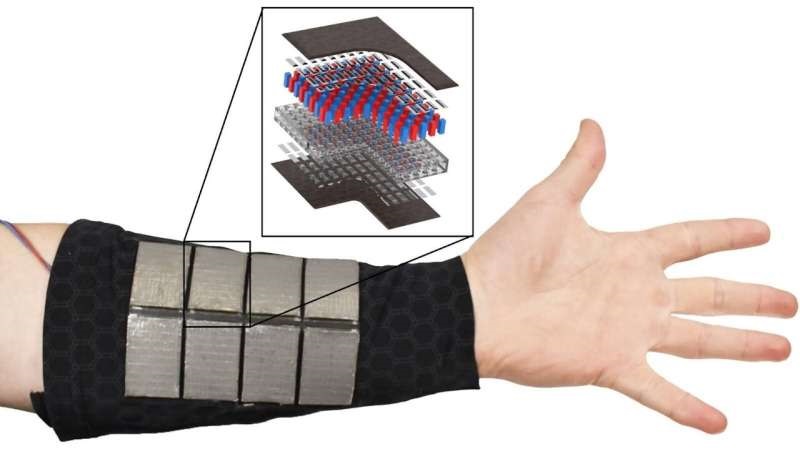Healthcare Device Powered By Body Heat Marks First Step Toward Battery-Free Wearable Electronics
|
By HospiMedica International staff writers Posted on 23 Jul 2024 |

Portable, wearable electronics for physiological monitoring are gaining preference over traditional tethered devices in clinical settings due to their convenience for continuous or frequent monitoring. However, they often face challenges in power supply, requiring either large batteries or frequent recharging, which may not be practical for long-term use, particularly when devices are in hard-to-reach places or are difficult to remove or reapply. In a novel development, researchers have now demonstrated that a healthcare device can be powered entirely by body heat. By integrating a pulse oximetry sensor with a flexible, stretchable, wearable thermoelectric power generator composed of liquid metal, semiconductors, and 3D-printed rubber, the novel approach offers a viable solution to battery life issues.
The team at Carnegie Mellon University’s Department of Mechanical Engineering (Pittsburgh, PA, USA) developed a new approach to extend the battery life of wearable devices by converting body heat into electrical energy using thermoelectric generators (TEGs). This innovation includes the creation of TEGsense, a health monitoring wearable that harnesses body heat for electricity to power a photonic sensing device without the need for batteries. This system utilizes high-performance TEGs made from 3D-printed elastomers blended with liquid metal epoxy polymer composites and thermoelectric semiconductors, ensuring elastic compliance and mechanical compatibility with the body.
These thermoelectric generators were tested in both energy harvesting (Seebeck) and active heating/cooling (Peltier) modes to assess their efficiency under different physical activities such as sitting, walking, and running. During tests, when worn on the forearm and engaged in outdoor walking, the TEG arrays successfully powered electronic circuitry to collect and wirelessly transmit photoplethysmography (PPG) waveform data to an external PC via Bluetooth Low Energy (BLE). The research also included testing the voltage output of these devices on the chest and wrist of participants who were at rest and in motion. Results indicated that device performance was enhanced on the wrist and during movement, benefiting from the increased airflow cooling on one side of the device while the other side was heated by the body, thus maximizing the temperature differential required for efficient energy generation.
“This is the first step toward battery-free wearable electronics,” said Mason Zadan, a graduate student and first author of the study published in Advanced Functional Materials.
Related Links:
Carnegie Mellon University’s Department of Mechanical Engineering
Latest Critical Care News
- Mass Manufactured Nanoparticles to Deliver Cancer Drugs Directly to Tumors
- World’s Smallest Pacemaker Fits Inside Syringe Tip

- AI-Powered, Internet-Connected Medical Devices to Revolutionize Healthcare, Finds Study
- Starfish-Inspired Wearable Tech Enables Smarter Heart Monitoring
- AI Eye Scans Could Help Identify Heart Disease and Stroke Risk
- Digital Heart Twin Improves Diagnosis and Treatment of Cardiac Arrhythmias
- First-Of-Its-Kind AI-Powered Probability Scoring System Assesses Heart Failure with Preserved Ejection Fraction
- AI-Assisted Colonoscopy Detects More Polyps but Has Modest Effect on Cancer Risk
- Wearables Could Reduce Need for Continuous Blood Thinners in Patients with Atrial Fibrillation
- AI Model Provides Real-Time Sepsis Risk Alerts for Improving ICU Patient Survival
- AI Algorithm Improves Intravenous Nutrition for Premature Babies
- Smart Mirror Generates AI-Powered Health Insights by Analyzing Facial Blood Flow
- Painless Diabetes Patch to Replace Needle Pricks

- Sensory T-Shirt Monitors Patient’s Vitals After Urological Surgery for Cancer
- Super-Sensitive Radar Technology Warns of Serious Heart Issues
- Thermal Imaging Could Accurately Track Vital Signs for Early Disease Detection
Channels
Surgical Techniques
view channel
New Transcatheter Valve Found Safe and Effective for Treating Aortic Regurgitation
Aortic regurgitation is a condition in which the aortic valve does not close properly, allowing blood to flow backward into the left ventricle. This results in decreased blood flow from the heart to the... Read more
Minimally Invasive Valve Repair Reduces Hospitalizations in Severe Tricuspid Regurgitation Patients
The tricuspid valve is one of the four heart valves, responsible for regulating blood flow from the right atrium (the heart's upper-right chamber) to the right ventricle (the lower-right chamber).... Read morePatient Care
view channel
Portable Biosensor Platform to Reduce Hospital-Acquired Infections
Approximately 4 million patients in the European Union acquire healthcare-associated infections (HAIs) or nosocomial infections each year, with around 37,000 deaths directly resulting from these infections,... Read moreFirst-Of-Its-Kind Portable Germicidal Light Technology Disinfects High-Touch Clinical Surfaces in Seconds
Reducing healthcare-acquired infections (HAIs) remains a pressing issue within global healthcare systems. In the United States alone, 1.7 million patients contract HAIs annually, leading to approximately... Read more
Surgical Capacity Optimization Solution Helps Hospitals Boost OR Utilization
An innovative solution has the capability to transform surgical capacity utilization by targeting the root cause of surgical block time inefficiencies. Fujitsu Limited’s (Tokyo, Japan) Surgical Capacity... Read more
Game-Changing Innovation in Surgical Instrument Sterilization Significantly Improves OR Throughput
A groundbreaking innovation enables hospitals to significantly improve instrument processing time and throughput in operating rooms (ORs) and sterile processing departments. Turbett Surgical, Inc.... Read moreHealth IT
view channel
Printable Molecule-Selective Nanoparticles Enable Mass Production of Wearable Biosensors
The future of medicine is likely to focus on the personalization of healthcare—understanding exactly what an individual requires and delivering the appropriate combination of nutrients, metabolites, and... Read more
Smartwatches Could Detect Congestive Heart Failure
Diagnosing congestive heart failure (CHF) typically requires expensive and time-consuming imaging techniques like echocardiography, also known as cardiac ultrasound. Previously, detecting CHF by analyzing... Read morePoint of Care
view channel
Handheld, Sound-Based Diagnostic System Delivers Bedside Blood Test Results in An Hour
Patients who go to a doctor for a blood test often have to contend with a needle and syringe, followed by a long wait—sometimes hours or even days—for lab results. Scientists have been working hard to... Read moreBusiness
view channel
Expanded Collaboration to Transform OR Technology Through AI and Automation
The expansion of an existing collaboration between three leading companies aims to develop artificial intelligence (AI)-driven solutions for smart operating rooms with sophisticated monitoring and automation.... Read more


















